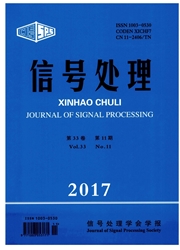

 中文摘要:
中文摘要:
本文提出了一种基于变差函数纹理特征的高分辨率SAR图像建筑区提取方法,该方法以建筑区变差函数曲线的周期性为依据,首先提取周期性变差函数曲线的变程,然后以该变程为间距计算相应的变差函数值作为分类特征,最后采用非监督模糊C-均值(FCM,Fuzzy C-Mean)分类器实现建筑区和非建筑区两类分类问题,在去除小区域和填补空洞的操作之后,提取最终的建筑区轮廓。在实际计算变差函数特征图像时,为提高算法的实用性,将全方向的变差函数计算转化为四个方向的变差函数之和,并提出快速递推算法以替代常用的逐点加窗计算方式。实验结果表明,利用变差函数纹理特征可以有效地区分高分辨率SAR图像上的建筑区与非建筑区,提取出来的建筑区完整性较高,且虚警较少。与经典的灰度共生矩阵法(GLCM,Gray Level Co-occurrence Matrix)相比,本文方法在应用于不同高分辨率SAR图像的建筑区提取时,其性能可媲美甚至优于经典的GLCM法,而在计算效率上远远高于GLCM法,因而更具有实用的意义。
 英文摘要:
英文摘要:
This paper proposes a method for extracting built-up areas from high-resolution SAR images based on variogram textural feature. Since the variogram curves of the built-up areas in airborne SAR images usually shows distinct periodicity,we first extract the range, which is defined as the first peak of the variogram. Second, with the range as the lag, the corresponding variogram is computed as feature for classification. Finally,an unsupervised FCM classifier is used for the binary classification (built-up and non-built-up) and the boundaries of built-up areas are extracted after removing small regions and filling holes. To improve the practicability of the method, when computing the variograms of each pixel in the whole image, the omnidirectional variogram is decomposed into 4 directional variograms and the fast recursive algorithm is proposed. The experimental results show that the built-up and non-built-up areas can be well distinguished by the variogram feature. Comparison with the classic GLCM (Gray Level Co-occurrence Matrix)method indicate that the results of the proposed method are better than the results of GLCM in the application of extracting buih-up areas from high-resolution SAR images. And the proposed method has much higher computational efficiency, which makes it more practical.
 同期刊论文项目
同期刊论文项目
 同项目期刊论文
同项目期刊论文
 期刊信息
期刊信息
